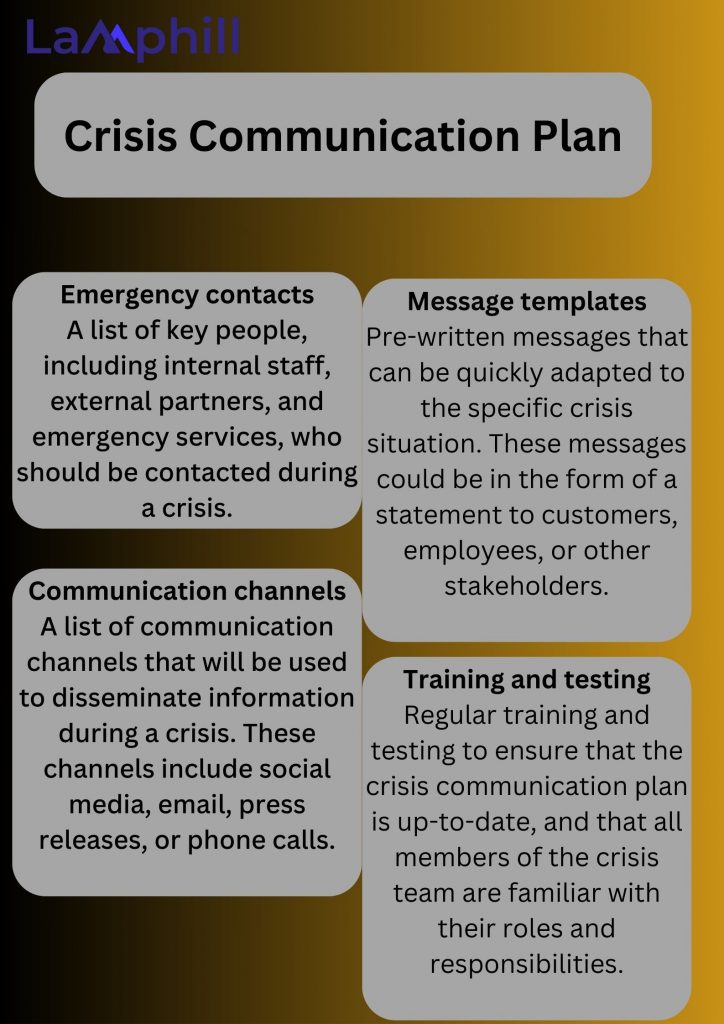Don’t let a crisis define you. Protect your reputation with our crisis management service. Unlike the conventional response, we do not react to problems but proactively assess risks to prepare you for anything. I couldn’t agree more with you on the importance of having a crisis communication plan for organizations. As someone who has witnessed the impact of unexpected situations, I can attest that a well-thought-out plan can be the difference between a company weathering the storm and sinking. The COVID-19 pandemic serves as a perfect example of this – businesses that had a solid crisis communication plan in place were able to navigate the situation much better than those that didn’t. Companies need to understand that a crisis can strike at any moment, and having a plan in place can help mitigate the damage and ensure a swift recovery.
Key Points
- A crisis communication plan is essential for handling unexpected situations.
- Organizations should anticipate various potential crises and proactively prepare for them.
- The best strategies for crisis communication include being transparent and timely, acknowledging the issue, presenting a plan of action, designating a spokesperson or team, providing regular updates, monitoring social media and other channels, and having a plan in place.
- Crisis communication agencies can assist organizations in developing and executing an effective crisis communication plan.
- Johnson & Johnson’s Tylenol Recall (1982) is an example of effective crisis communication.
- Essential Content, Net Reputation, and Red Banyan are some crisis communication agencies organizations can consider for crisis management, issues management, and stakeholder engagement.
What is Crisis Communication?
Crisis communication utilizes technologies, systems, and protocols to communicate effectively during a significant threat to an organization’s reputation or business. To be well-prepared for any possible crisis, organizations should anticipate various crises, including extreme weather, crime, cyber-attacks, product recalls, corporate malfeasance, reputation crises, and PR incidents.
Being proactive and preparing for a crisis beforehand ensures that relevant personnel can quickly and efficiently communicate with each other during critical moments, sharing information that enables the organization to rectify the situation, protect its customers, employees, and assets, and maintain business continuity.
Strategies for Crisis Communication

I recommend these strategies for crisis communication:
- Be transparent and timely: When a crisis occurs, it’s important to communicate with stakeholders as soon as possible. You should provide clear and honest information about the situation and what you are doing to address it.
- Acknowledge the issue: It’s important to show that you understand the impact of the crisis on your stakeholders. You can do this by expressing empathy and concern.
- Present a plan of action: It’s important to provide a clear plan for addressing the crisis and preventing it from happening again. This helps reassure stakeholders that the situation is being taken seriously.
- Designate a spokesperson or team: It’s important to have a designated team or spokesperson who handles communication with stakeholders. This helps ensure that messaging is consistent and that information is provided promptly.
- Provide regular updates: It’s important to keep stakeholders informed as the situation evolves. This can help to manage expectations and prevent misinformation from spreading.
- Monitor social media and other channels: It’s important to monitor social media and other channels for feedback and to address any misinformation or rumors that may arise. This can help to prevent the situation from escalating further.
- Have a plan in place: It’s important to have one before a crisis occurs. This should include pre-approved messaging and protocols for escalation if needed. Having a plan in place helps ensure that communication is handled promptly and effectively.
Crisis Communication Plan
Crisis communication plans are blueprints for companies to respond immediately during a crisis. Emergency plans include communication steps and future prevention to help prepare for and navigate unexpected crises.

Crisis Communication Example
One example of crisis communication I researched about was Johnson & Johnson’s Tylenol Recall (1982). In 1982, Johnson & Johnson faced a major crisis when several deaths were linked to their popular product, Tylenol. It was discovered that some of the Tylenol capsules were laced with cyanide. In response, Johnson & Johnson immediately issued a nationwide recall of all Tylenol products from the market.
They also organized press conferences to inform the public about the situation and reassure them of their commitment to safety. Their swift and transparent response to the crisis is now a well-known example of effective crisis communication.
Crisis Communication Agencies
Here are some of the crisis communication agencies you should know:
#1. LampHills
LampHills aims to redefine reputation management, empowering individuals and brands to create narratives with purpose, authenticity, and impact. We believe every story deserves to be told with integrity and resonance, using innovative strategies and creativity to navigate the public space. Our commitment to professionalism, exceptional results, and transparency is at the core of our approach, which is a client-centric approach where success is a shared journey. We are more than just a service provider; we are your partners in progress and well-curated perceptions.
We act swiftly and strategically to minimize damage and protect your credibility during a crisis, so your audience’s trust remains unshaken. But don’t wait until a crisis strikes; contact us now.
#2. Net Reputation
NetReputation is a company that provides Online Reputation Management Services. Otter Public Relations is the fastest-growing PR agency in the USA and is a part of NetReputation. This company boasts a team of over 35 publicists and media partners who collaborate to ensure that your story gets covered by local and national media. By utilizing the latest technology and following the most effective procedures, they provide exceptional services to their clients. Their ultimate goal is to help businesses and individuals improve, restore, or establish a positive online reputation.
#3. Essential Content
Essential Content has a track record of helping brands, businesses, and organizations protect their reputations at the times that matter most. They specialize in crisis management, issues management, and stakeholder engagement for challenging times, such as:
- Data breaches
- Cybercrime
- Damaging allegations
- Vexatious complaints
- Key contractor issues
- On-site incidents
- Damaging media coverage
#4. Red Banyan
Red Banyan is a global crisis communications firm with offices in Washington, Los Angeles, New York, Miami, and Atlanta. The agency specializes in public relations, crisis management, crisis communications, social media, and marketing. Red Banyan is known for its creative thinking, steady judgment shaped by experience, and relentless commitment to achieving client results.
#5. Miller Ink
Miller Ink is a strategic communications and crisis PR firm in Los Angeles. The firm provides full-service assistance to businesses, executives, and non-profits to amplify their voices, build their brands, and advance their goals. Miller Ink achieves this through carefully crafted messaging and compelling content.
#6. Otter Public Relations
Otter Public Relations is the fastest-growing PR agency in the USA. Their growing team of 35+ publicists and media partners focuses on getting your story told in the local and national media.
Otter Public Relations is a boutique PR agency specializing in media relations, social media, and content creation. The agency is known for its personalized approach, attention to detail, and ability to generate meaningful client results. Based in Los Angeles, Otter Public Relations has worked with clients in various industries, including entertainment, lifestyle, and technology. The agency’s experienced professionals are dedicated to creating customized campaigns that help clients achieve their business goals.
What Are the 5 CS of Crisis Communication?
#1. Concern
It is important to show concern for those affected by the crisis, whether they are employees, customers, or community members. This means acknowledging their feelings and providing support and assistance as needed.
#2. Commitment
Your organization should demonstrate its commitment to resolving the crisis and preventing similar incidents. This involves taking responsibility for any mistakes and showing a willingness to learn and improve.
#3. Competency
Your organization should demonstrate its competence in managing the crisis. This means having the right people and resources in place to respond quickly and effectively, as well as clear procedures and protocols.
#4. Clarity
Your communication should be clear and concise, avoiding technical jargon or confusing language. This helps to ensure that your message is understood by all stakeholders and that there is no room for misinterpretation.
#5. Confidence
Your communication should be delivered with confidence and authority. This helps build trust with your audience and shows that your organization controls the situation. It is important to note that confidence should not be mistaken for arrogance or dismissiveness but rather for a calm and collected demeanor that inspires trust.
Checklist on Crisis Communication Strategy
What Are the Five Phases of Crisis Communication?

- Stage 1: Recognizing the Crisis
- Stage 2: Initial Response.
- Stage 3: Managing the Situation
- Stage 4: Creating Flexibility in Pre-recovery
- Stage 5: Time to Recover
What Is Crisis Communication Also Known As?
Crisis communication is also known as emergency communication, issues management, or risk communication. It involves preparing for and responding to an unexpected event or situation that can harm an organization’s reputation, operations, or stakeholders. The main goal of crisis communication is to protect the organization’s credibility and maintain the trust of its stakeholders during and after a crisis.
Important Tools and Resources for Crisis Communication
In times of crisis, it can be helpful to have various tools and resources available to aid in communication and mitigation. These might include communication devices like phones and fax machines, copies of emergency response and crisis communication plans, active social media accounts for posting updates, building and site diagrams to facilitate evacuations, forms for documenting events, message boards for sharing updates with employees, and webmaster tools or personnel for quick website updates. Additionally, a call tree can be a useful tool to have in the toolkit.
This method involves one person calling a designated contact, calling another designated contact, and so on. If someone cannot be reached, the caller moves on to the next contact to ensure the chain is not broken. While this method relies on human interaction, there are potential issues if some people cannot be reached. Automated call tree software is also available to minimize the effort and time required. The software can make simultaneous calls to multiple people, reducing or eliminating potential breaks and ensuring the maximum number of people are informed.
Related Post
Crisis Management Plan: Steps To Crafting The Best Crisis Management Plan (+ Free Templates
HOW TO REPORT A BLACKMAIL: All You Need To Know






